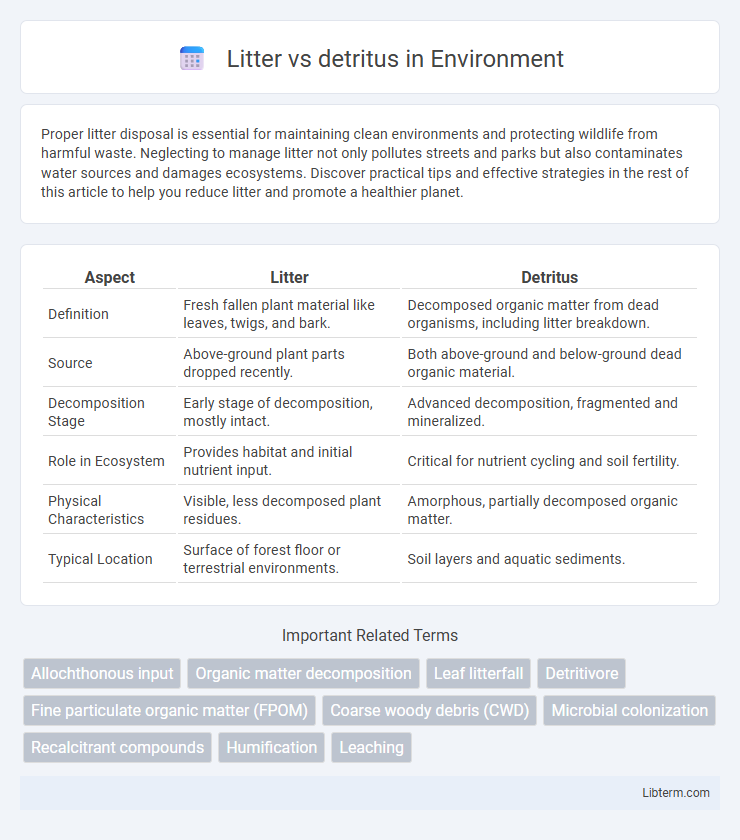Proper litter disposal is essential for maintaining clean environments and protecting wildlife from harmful waste. Neglecting to manage litter not only pollutes streets and parks but also contaminates water sources and damages ecosystems. Discover practical tips and effective strategies in the rest of this article to help you reduce litter and promote a healthier planet.
Table of Comparison
| Aspect | Litter | Detritus |
|---|---|---|
| Definition | Fresh fallen plant material like leaves, twigs, and bark. | Decomposed organic matter from dead organisms, including litter breakdown. |
| Source | Above-ground plant parts dropped recently. | Both above-ground and below-ground dead organic material. |
| Decomposition Stage | Early stage of decomposition, mostly intact. | Advanced decomposition, fragmented and mineralized. |
| Role in Ecosystem | Provides habitat and initial nutrient input. | Critical for nutrient cycling and soil fertility. |
| Physical Characteristics | Visible, less decomposed plant residues. | Amorphous, partially decomposed organic matter. |
| Typical Location | Surface of forest floor or terrestrial environments. | Soil layers and aquatic sediments. |
Understanding Litter and Detritus: Key Definitions
Litter refers to fresh plant material such as leaves, twigs, and dead grass that accumulates on the soil surface, serving as the initial stage of organic matter decomposition. Detritus consists of decomposed organic matter, including fragmented litter and microbial biomass, playing a crucial role in nutrient cycling within ecosystems. Understanding the distinction between litter and detritus is essential for studying decomposition processes and soil fertility dynamics.
Origins of Litter and Detritus in Ecosystems
Litter originates primarily from the shedding of leaves, twigs, and other plant materials in terrestrial ecosystems, forming the initial layer of organic matter on the soil surface. Detritus consists of decomposed organic matter derived from both litter and dead organisms, including animal remains and microbial biomass, playing a crucial role in nutrient cycling. In aquatic ecosystems, detritus often accumulates from plankton, algae, and organic debris, serving as a key energy source for detritivores and decomposers.
Composition Differences: Litter vs Detritus
Litter primarily consists of freshly fallen plant materials like leaves, twigs, and bark, rich in cellulose, lignin, and other complex carbohydrates. Detritus, on the other hand, includes decomposed organic matter at various stages, containing more fragmented compounds such as humic substances and microbial biomass residues. The chemical composition of litter is dominated by structural plant polymers, while detritus shows increased mineralization and nutrient availability due to microbial processing.
Role in Soil Formation and Health
Litter, comprising fresh plant material such as leaves and twigs, serves as an immediate source of organic matter that initiates soil formation by enhancing microbial activity and nutrient cycling. Detritus, which includes decomposed organic residues, contributes to the development of humus, improving soil structure, water retention, and fertility. Both litter and detritus play essential roles in sustaining soil health by promoting nutrient availability and supporting diverse soil biota.
Decomposition Processes of Litter and Detritus
Litter decomposition primarily involves the breakdown of fresh plant material such as leaves, stems, and roots through microbial and faunal activity, releasing nutrients back into the soil. Detritus decomposition includes older, partially decomposed organic matter that undergoes further microbial mineralization, contributing to soil organic matter formation. Both processes are crucial for nutrient cycling, but litter decomposition typically occurs faster due to higher nutrient content and labile compounds compared to more recalcitrant detritus.
Impact on Nutrient Cycling
Litter and detritus both play crucial roles in nutrient cycling by providing organic matter that decomposers break down, releasing essential nutrients into the soil. Litter, composed of fresh plant material like leaves and twigs, typically decomposes faster, supplying a rapid influx of nitrogen, phosphorus, and carbon. Detritus, consisting of more decomposed organic matter, contributes to long-term nutrient storage and gradually enriches soil fertility through slower decomposition processes.
Effects of Litter and Detritus on Biodiversity
Litter and detritus play crucial roles in enhancing biodiversity by providing essential habitats and nutrient sources for a wide range of organisms, from microbes to larger decomposers. The presence of diverse litter types influences soil structure, moisture retention, and nutrient cycling, which supports varied plant and animal communities. Detritus accumulation fosters microbial diversity and detritivore populations, promoting ecosystem stability and resilience, ultimately enriching overall biodiversity.
Human Influence on Natural Litter and Detritus
Human activities significantly alter the composition and quantity of natural litter and detritus by increasing the introduction of synthetic materials and pollutants into ecosystems. Urbanization and agriculture contribute to altered nutrient cycling and decomposition rates, impacting soil health and aquatic systems through fragmented or contaminated organic matter. Waste management practices and land use changes disrupt natural detrital food webs, reducing biodiversity and ecosystem resilience.
Environmental Consequences of Improper Litter Management
Improper litter management leads to increased soil and water pollution, disrupting nutrient cycles and harming aquatic ecosystems. Accumulated litter can cause oxygen depletion in water bodies through excessive microbial decomposition, contributing to eutrophication. Detritus, in contrast, naturally recycles organic material, supporting biodiversity and maintaining ecosystem health.
Strategies for Sustainable Litter and Detritus Management
Effective strategies for sustainable litter and detritus management include implementing source reduction techniques, promoting composting programs, and enhancing public education on waste segregation. Utilizing advanced biodegradation technologies and encouraging the use of eco-friendly packaging materials can significantly decrease environmental impact. Municipalities benefit from integrating smart waste collection systems and regulatory frameworks that support circular economy practices in managing organic and inorganic litter and detritus.
Litter Infographic

 libterm.com
libterm.com